HRM 325: Strategic Human Resource Management and Employment Report
VerifiedAdded on 2022/10/10
|21
|4896
|500
Report
AI Summary
This report, prepared for a Strategic Human Resource Management (HRM 325) course, provides a comprehensive analysis of strategic human resource management (SHRM) and employment relations. It begins by exploring the crucial relationship between HR strategy and business strategy, examining various models like the separation, best-fit, dialogue, holistic, and HR-driven models. The report delves into vertical alignment, horizontal integration, and the theoretical perspectives of SHRM, including universalistic, contingency, and resource-based view theories. It also examines the role of performance management and reward systems in achieving organizational goals and employee motivation. Furthermore, the report addresses employment relationships, their theoretical perspectives (unitary, pluralistic, and radicalism), and the roles of actors involved. It discusses employee participation and voice mechanisms, offering recommendations for improving employment relations. The report concludes with a discussion of SHRM practices and their impact on organizational performance, providing valuable insights for business leaders and HRM professionals.
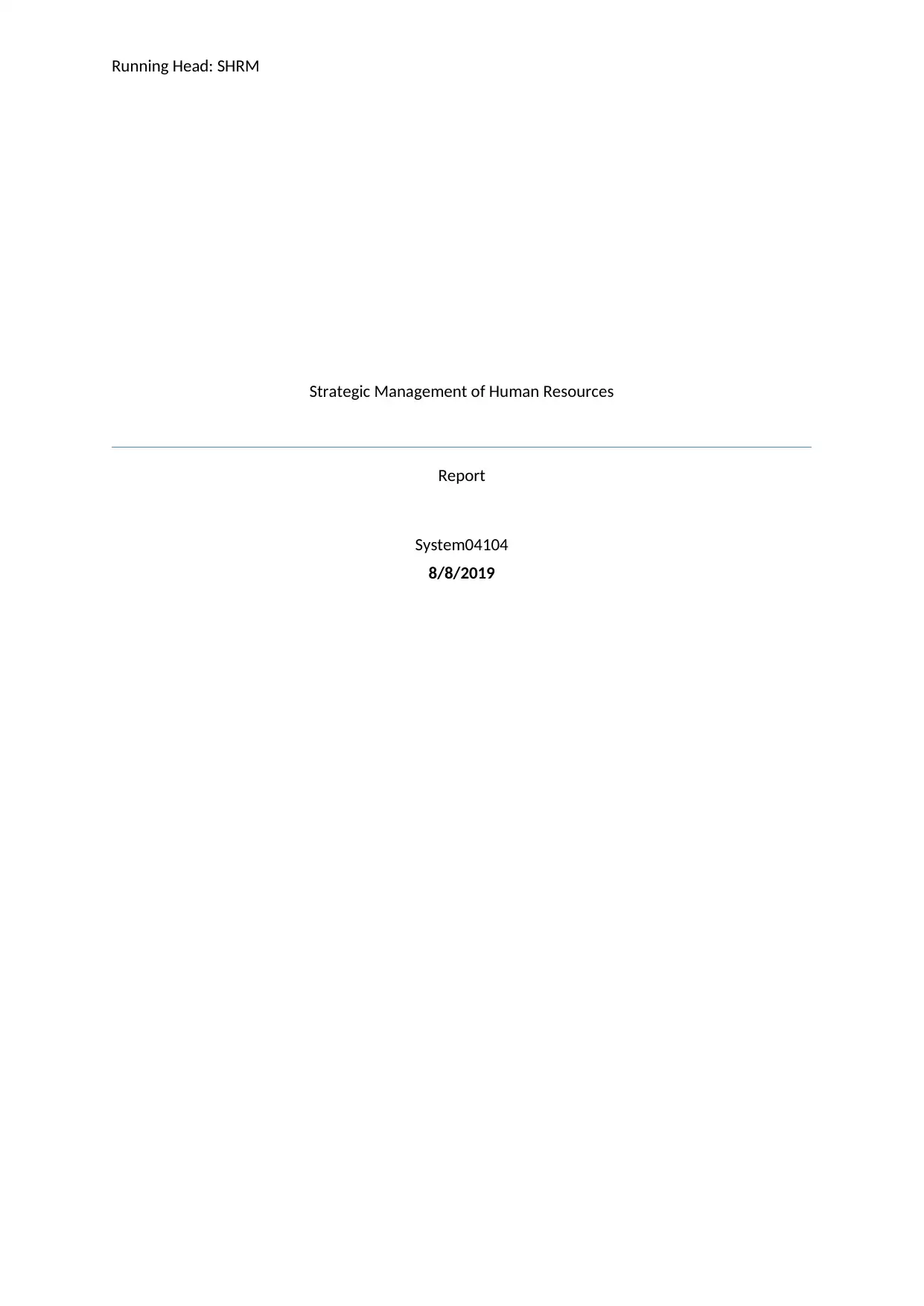
Running Head: SHRM
Strategic Management of Human Resources
Report
System04104
8/8/2019
Strategic Management of Human Resources
Report
System04104
8/8/2019
Paraphrase This Document
Need a fresh take? Get an instant paraphrase of this document with our AI Paraphraser
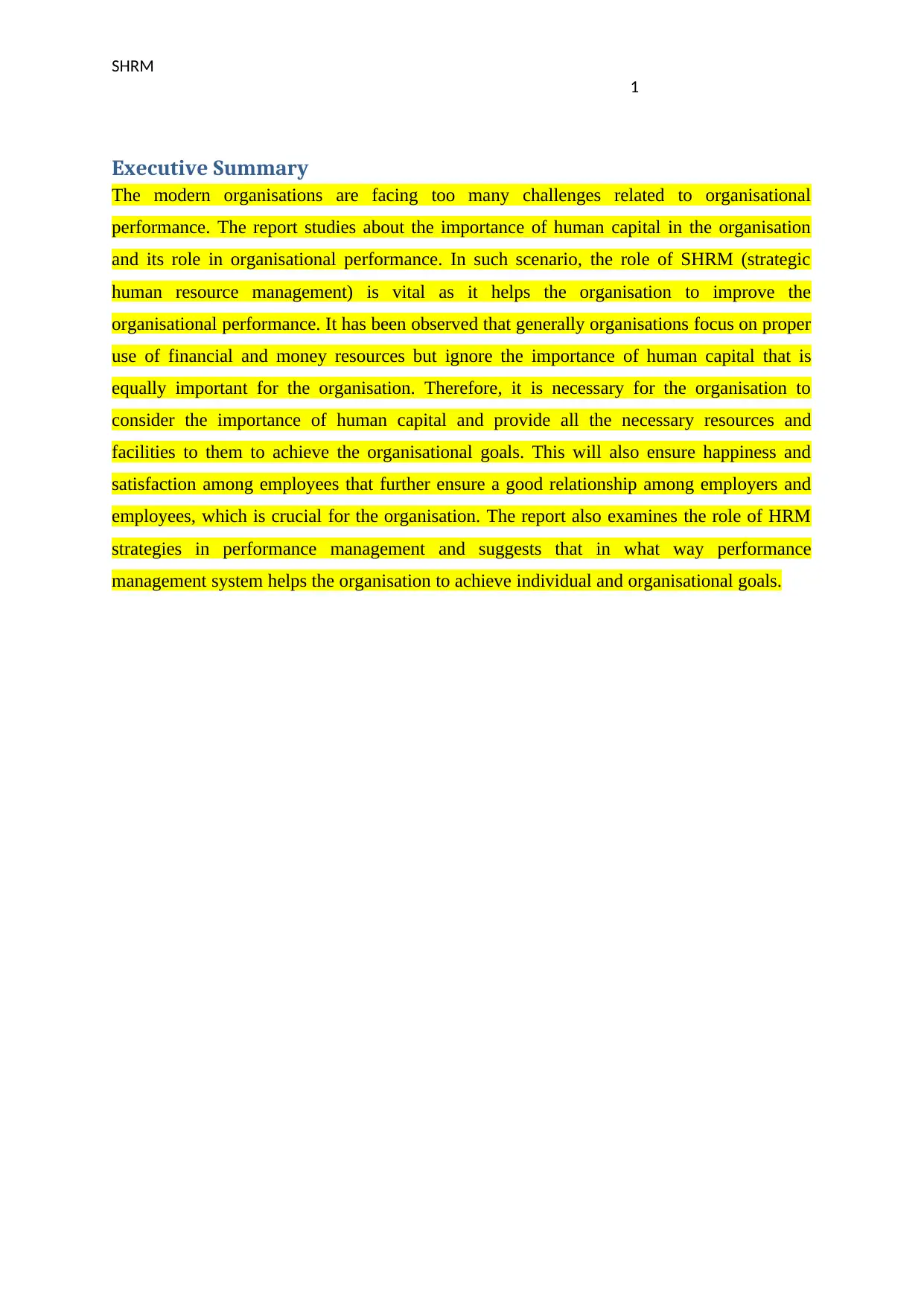
SHRM
1
Executive Summary
The modern organisations are facing too many challenges related to organisational
performance. The report studies about the importance of human capital in the organisation
and its role in organisational performance. In such scenario, the role of SHRM (strategic
human resource management) is vital as it helps the organisation to improve the
organisational performance. It has been observed that generally organisations focus on proper
use of financial and money resources but ignore the importance of human capital that is
equally important for the organisation. Therefore, it is necessary for the organisation to
consider the importance of human capital and provide all the necessary resources and
facilities to them to achieve the organisational goals. This will also ensure happiness and
satisfaction among employees that further ensure a good relationship among employers and
employees, which is crucial for the organisation. The report also examines the role of HRM
strategies in performance management and suggests that in what way performance
management system helps the organisation to achieve individual and organisational goals.
1
Executive Summary
The modern organisations are facing too many challenges related to organisational
performance. The report studies about the importance of human capital in the organisation
and its role in organisational performance. In such scenario, the role of SHRM (strategic
human resource management) is vital as it helps the organisation to improve the
organisational performance. It has been observed that generally organisations focus on proper
use of financial and money resources but ignore the importance of human capital that is
equally important for the organisation. Therefore, it is necessary for the organisation to
consider the importance of human capital and provide all the necessary resources and
facilities to them to achieve the organisational goals. This will also ensure happiness and
satisfaction among employees that further ensure a good relationship among employers and
employees, which is crucial for the organisation. The report also examines the role of HRM
strategies in performance management and suggests that in what way performance
management system helps the organisation to achieve individual and organisational goals.

SHRM
2
Table of Contents
Executive Summary...................................................................................................................1
PART-1......................................................................................................................................3
1. Relationship between HR Strategy and Business Strategy.................................................3
What is Business Strategy?.................................................................................................3
What is HR Strategy?.........................................................................................................3
The Link between Business Strategy and HR Strategy..........................................................4
2. Vertical Alignment and Horizontal Integration..................................................................6
1. Theoretical Perspective of SHRM......................................................................................7
4. Performance Management and Reward..............................................................................9
Activities of HR in Performance Management:.....................................................................9
Activities of HR in Reward Management:...........................................................................10
5. Recommendations for Organisational Design Effective Performance Management
System......................................................................................................................................10
6. Conclusion........................................................................................................................11
PART-2....................................................................................................................................12
1. Introduction.......................................................................................................................12
2. Employment Relationship and Its Nature.........................................................................12
3. Employment Relations and Its Theoretical Perspective...................................................12
1. Unitary Perspective:......................................................................................................13
4. Pluralistic Perspective:..................................................................................................13
5. Radicalism perspective:................................................................................................13
6. Roles of the Actors in Employment Relationship............................................................13
5. Fluctuating nature of Occupational Relation....................................................................14
6. Mechanism of Employee Participation and Employee Voice..........................................14
Mechanism of Employee Participation................................................................................15
2
Table of Contents
Executive Summary...................................................................................................................1
PART-1......................................................................................................................................3
1. Relationship between HR Strategy and Business Strategy.................................................3
What is Business Strategy?.................................................................................................3
What is HR Strategy?.........................................................................................................3
The Link between Business Strategy and HR Strategy..........................................................4
2. Vertical Alignment and Horizontal Integration..................................................................6
1. Theoretical Perspective of SHRM......................................................................................7
4. Performance Management and Reward..............................................................................9
Activities of HR in Performance Management:.....................................................................9
Activities of HR in Reward Management:...........................................................................10
5. Recommendations for Organisational Design Effective Performance Management
System......................................................................................................................................10
6. Conclusion........................................................................................................................11
PART-2....................................................................................................................................12
1. Introduction.......................................................................................................................12
2. Employment Relationship and Its Nature.........................................................................12
3. Employment Relations and Its Theoretical Perspective...................................................12
1. Unitary Perspective:......................................................................................................13
4. Pluralistic Perspective:..................................................................................................13
5. Radicalism perspective:................................................................................................13
6. Roles of the Actors in Employment Relationship............................................................13
5. Fluctuating nature of Occupational Relation....................................................................14
6. Mechanism of Employee Participation and Employee Voice..........................................14
Mechanism of Employee Participation................................................................................15
⊘ This is a preview!⊘
Do you want full access?
Subscribe today to unlock all pages.

Trusted by 1+ million students worldwide

SHRM
3
Mechanism of Employee Voice...........................................................................................15
7. Recommendations for improving employment relations..................................................15
8. Conclusion........................................................................................................................16
References................................................................................................................................17
3
Mechanism of Employee Voice...........................................................................................15
7. Recommendations for improving employment relations..................................................15
8. Conclusion........................................................................................................................16
References................................................................................................................................17
Paraphrase This Document
Need a fresh take? Get an instant paraphrase of this document with our AI Paraphraser

SHRM
4
PART-1
The report includes a discussion over the human resource management and human
relationship management. In the dynamic business environment and sophisticated modern
business activities, it is really crucial for the organisation to implement the practices and
models of SHRM in the organisation to improve the performance of individuals and
organisation. Both SHRM and human relationship plays a crucial role in different
organisation. To achieve greater results and outcomes every organisation depends on these
two factors. However, to understand the relationship between these two factors, various
researchers develops some significant models that are helpful in understanding the role of
SHRM and human relation management in the organisation.
1. Relationship between HR Strategy and Business Strategy
The success of an organisation depends on the business strategy of an organisation. However,
the success of business strategy is only possible if the organisation manages the resources in
such a way that they work to achieve the organisational goals of the organisation. Therefore,
a correlation in business strategy ad HR strategy is really important for the organisation:
What is Business Strategy?
Business strategy is a term that is used by organisation to gain competitive advantages over
the competitors. It focuses on getting success in its chosen marketplace. Business strategy
helps the organisation to establish coordination with the business environment. It also helps
to makes coordination according to the environmental changes adjust and control the human
resources in the organisation. The business strategy of an organisation reflects the thinking
and intentions of the owner or top-level managers that what they are going to achieve in the
long term (Festing, 2012).
What is HR Strategy?
HR Strategy helps the organisation to manage the human capital in the organisation and
ensure that every employee in the organisation is performing in order to achieve
organisational goals in efficient an effective manner. The HR strategy also helps the
organisation to increase the efficiency of employees, so the organisation can reduce the
overall operational cost and improve its productivity (Marler and Fisher, 2013).
4
PART-1
The report includes a discussion over the human resource management and human
relationship management. In the dynamic business environment and sophisticated modern
business activities, it is really crucial for the organisation to implement the practices and
models of SHRM in the organisation to improve the performance of individuals and
organisation. Both SHRM and human relationship plays a crucial role in different
organisation. To achieve greater results and outcomes every organisation depends on these
two factors. However, to understand the relationship between these two factors, various
researchers develops some significant models that are helpful in understanding the role of
SHRM and human relation management in the organisation.
1. Relationship between HR Strategy and Business Strategy
The success of an organisation depends on the business strategy of an organisation. However,
the success of business strategy is only possible if the organisation manages the resources in
such a way that they work to achieve the organisational goals of the organisation. Therefore,
a correlation in business strategy ad HR strategy is really important for the organisation:
What is Business Strategy?
Business strategy is a term that is used by organisation to gain competitive advantages over
the competitors. It focuses on getting success in its chosen marketplace. Business strategy
helps the organisation to establish coordination with the business environment. It also helps
to makes coordination according to the environmental changes adjust and control the human
resources in the organisation. The business strategy of an organisation reflects the thinking
and intentions of the owner or top-level managers that what they are going to achieve in the
long term (Festing, 2012).
What is HR Strategy?
HR Strategy helps the organisation to manage the human capital in the organisation and
ensure that every employee in the organisation is performing in order to achieve
organisational goals in efficient an effective manner. The HR strategy also helps the
organisation to increase the efficiency of employees, so the organisation can reduce the
overall operational cost and improve its productivity (Marler and Fisher, 2013).
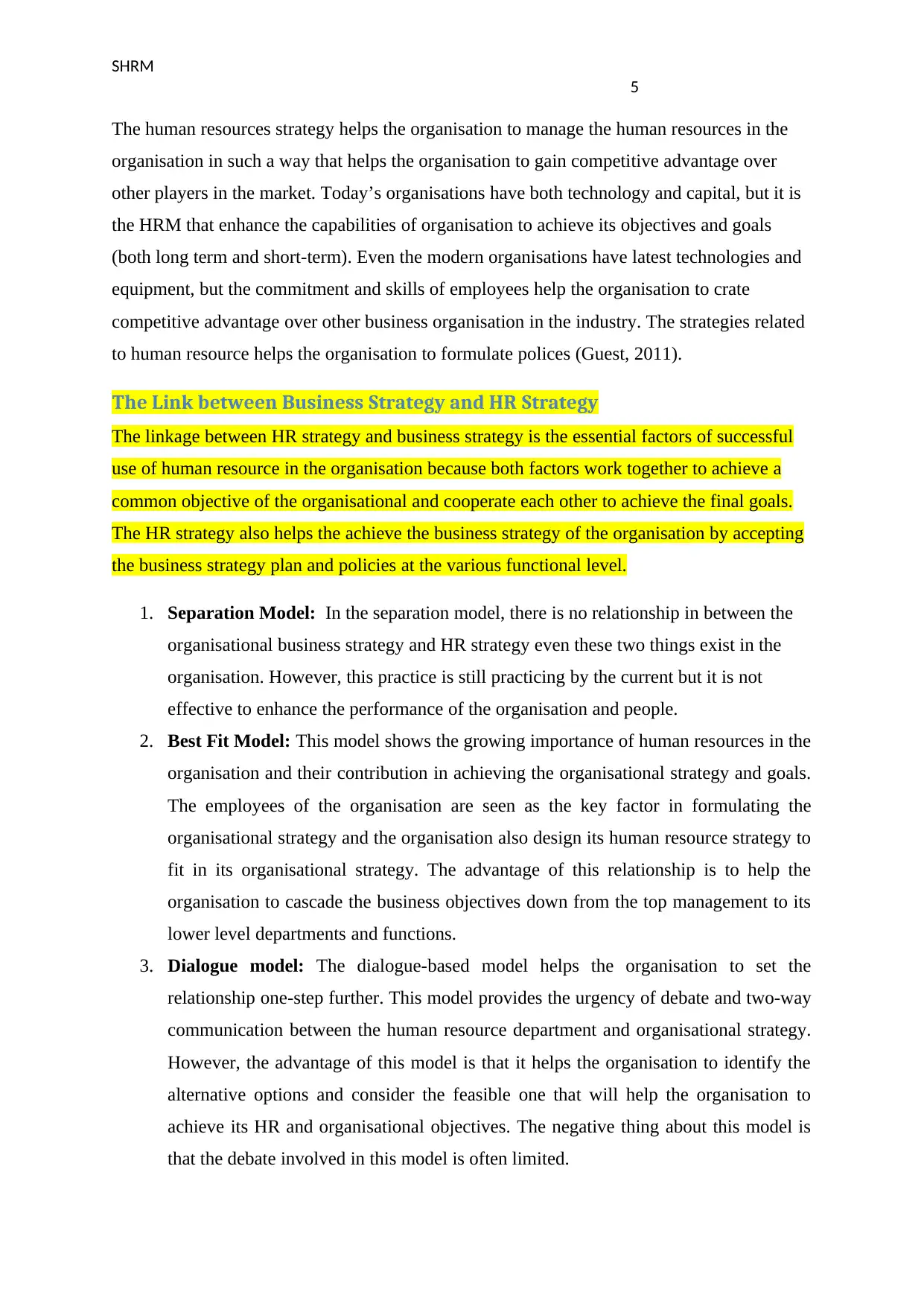
SHRM
5
The human resources strategy helps the organisation to manage the human resources in the
organisation in such a way that helps the organisation to gain competitive advantage over
other players in the market. Today’s organisations have both technology and capital, but it is
the HRM that enhance the capabilities of organisation to achieve its objectives and goals
(both long term and short-term). Even the modern organisations have latest technologies and
equipment, but the commitment and skills of employees help the organisation to crate
competitive advantage over other business organisation in the industry. The strategies related
to human resource helps the organisation to formulate polices (Guest, 2011).
The Link between Business Strategy and HR Strategy
The linkage between HR strategy and business strategy is the essential factors of successful
use of human resource in the organisation because both factors work together to achieve a
common objective of the organisational and cooperate each other to achieve the final goals.
The HR strategy also helps the achieve the business strategy of the organisation by accepting
the business strategy plan and policies at the various functional level.
1. Separation Model: In the separation model, there is no relationship in between the
organisational business strategy and HR strategy even these two things exist in the
organisation. However, this practice is still practicing by the current but it is not
effective to enhance the performance of the organisation and people.
2. Best Fit Model: This model shows the growing importance of human resources in the
organisation and their contribution in achieving the organisational strategy and goals.
The employees of the organisation are seen as the key factor in formulating the
organisational strategy and the organisation also design its human resource strategy to
fit in its organisational strategy. The advantage of this relationship is to help the
organisation to cascade the business objectives down from the top management to its
lower level departments and functions.
3. Dialogue model: The dialogue-based model helps the organisation to set the
relationship one-step further. This model provides the urgency of debate and two-way
communication between the human resource department and organisational strategy.
However, the advantage of this model is that it helps the organisation to identify the
alternative options and consider the feasible one that will help the organisation to
achieve its HR and organisational objectives. The negative thing about this model is
that the debate involved in this model is often limited.
5
The human resources strategy helps the organisation to manage the human resources in the
organisation in such a way that helps the organisation to gain competitive advantage over
other players in the market. Today’s organisations have both technology and capital, but it is
the HRM that enhance the capabilities of organisation to achieve its objectives and goals
(both long term and short-term). Even the modern organisations have latest technologies and
equipment, but the commitment and skills of employees help the organisation to crate
competitive advantage over other business organisation in the industry. The strategies related
to human resource helps the organisation to formulate polices (Guest, 2011).
The Link between Business Strategy and HR Strategy
The linkage between HR strategy and business strategy is the essential factors of successful
use of human resource in the organisation because both factors work together to achieve a
common objective of the organisational and cooperate each other to achieve the final goals.
The HR strategy also helps the achieve the business strategy of the organisation by accepting
the business strategy plan and policies at the various functional level.
1. Separation Model: In the separation model, there is no relationship in between the
organisational business strategy and HR strategy even these two things exist in the
organisation. However, this practice is still practicing by the current but it is not
effective to enhance the performance of the organisation and people.
2. Best Fit Model: This model shows the growing importance of human resources in the
organisation and their contribution in achieving the organisational strategy and goals.
The employees of the organisation are seen as the key factor in formulating the
organisational strategy and the organisation also design its human resource strategy to
fit in its organisational strategy. The advantage of this relationship is to help the
organisation to cascade the business objectives down from the top management to its
lower level departments and functions.
3. Dialogue model: The dialogue-based model helps the organisation to set the
relationship one-step further. This model provides the urgency of debate and two-way
communication between the human resource department and organisational strategy.
However, the advantage of this model is that it helps the organisation to identify the
alternative options and consider the feasible one that will help the organisation to
achieve its HR and organisational objectives. The negative thing about this model is
that the debate involved in this model is often limited.
⊘ This is a preview!⊘
Do you want full access?
Subscribe today to unlock all pages.

Trusted by 1+ million students worldwide
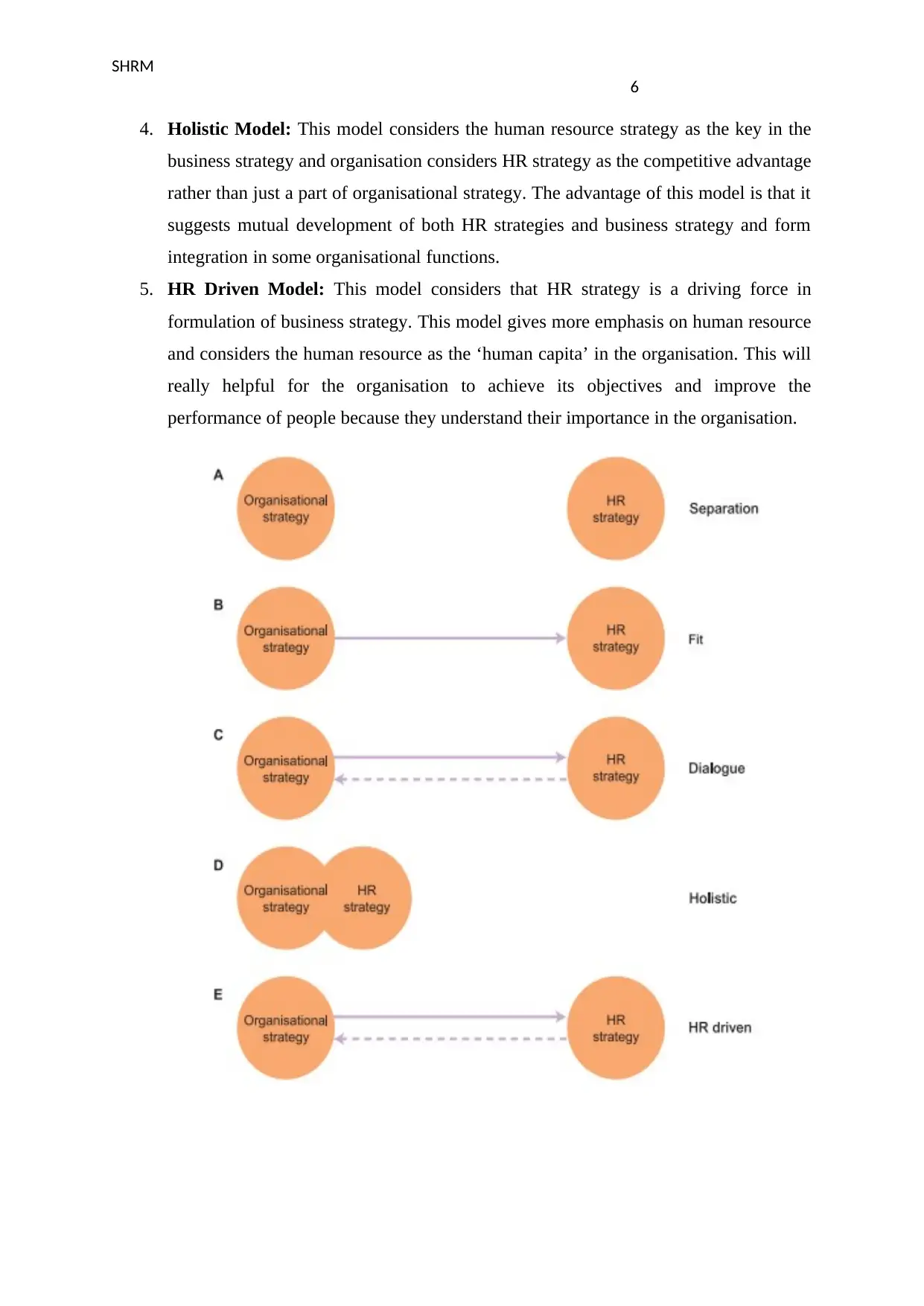
SHRM
6
4. Holistic Model: This model considers the human resource strategy as the key in the
business strategy and organisation considers HR strategy as the competitive advantage
rather than just a part of organisational strategy. The advantage of this model is that it
suggests mutual development of both HR strategies and business strategy and form
integration in some organisational functions.
5. HR Driven Model: This model considers that HR strategy is a driving force in
formulation of business strategy. This model gives more emphasis on human resource
and considers the human resource as the ‘human capita’ in the organisation. This will
really helpful for the organisation to achieve its objectives and improve the
performance of people because they understand their importance in the organisation.
6
4. Holistic Model: This model considers the human resource strategy as the key in the
business strategy and organisation considers HR strategy as the competitive advantage
rather than just a part of organisational strategy. The advantage of this model is that it
suggests mutual development of both HR strategies and business strategy and form
integration in some organisational functions.
5. HR Driven Model: This model considers that HR strategy is a driving force in
formulation of business strategy. This model gives more emphasis on human resource
and considers the human resource as the ‘human capita’ in the organisation. This will
really helpful for the organisation to achieve its objectives and improve the
performance of people because they understand their importance in the organisation.
Paraphrase This Document
Need a fresh take? Get an instant paraphrase of this document with our AI Paraphraser
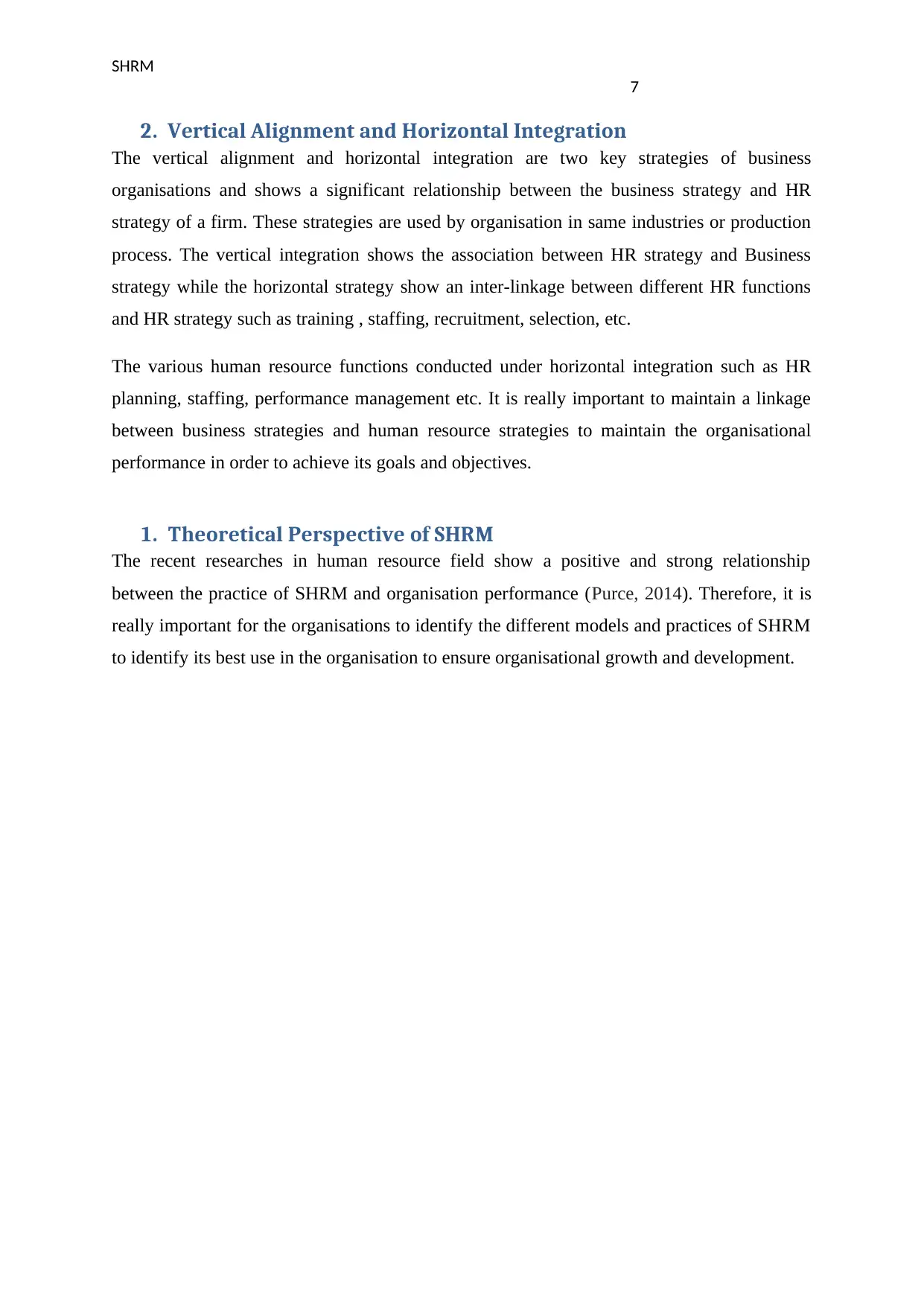
SHRM
7
2. Vertical Alignment and Horizontal Integration
The vertical alignment and horizontal integration are two key strategies of business
organisations and shows a significant relationship between the business strategy and HR
strategy of a firm. These strategies are used by organisation in same industries or production
process. The vertical integration shows the association between HR strategy and Business
strategy while the horizontal strategy show an inter-linkage between different HR functions
and HR strategy such as training , staffing, recruitment, selection, etc.
The various human resource functions conducted under horizontal integration such as HR
planning, staffing, performance management etc. It is really important to maintain a linkage
between business strategies and human resource strategies to maintain the organisational
performance in order to achieve its goals and objectives.
1. Theoretical Perspective of SHRM
The recent researches in human resource field show a positive and strong relationship
between the practice of SHRM and organisation performance (Purce, 2014). Therefore, it is
really important for the organisations to identify the different models and practices of SHRM
to identify its best use in the organisation to ensure organisational growth and development.
7
2. Vertical Alignment and Horizontal Integration
The vertical alignment and horizontal integration are two key strategies of business
organisations and shows a significant relationship between the business strategy and HR
strategy of a firm. These strategies are used by organisation in same industries or production
process. The vertical integration shows the association between HR strategy and Business
strategy while the horizontal strategy show an inter-linkage between different HR functions
and HR strategy such as training , staffing, recruitment, selection, etc.
The various human resource functions conducted under horizontal integration such as HR
planning, staffing, performance management etc. It is really important to maintain a linkage
between business strategies and human resource strategies to maintain the organisational
performance in order to achieve its goals and objectives.
1. Theoretical Perspective of SHRM
The recent researches in human resource field show a positive and strong relationship
between the practice of SHRM and organisation performance (Purce, 2014). Therefore, it is
really important for the organisations to identify the different models and practices of SHRM
to identify its best use in the organisation to ensure organisational growth and development.
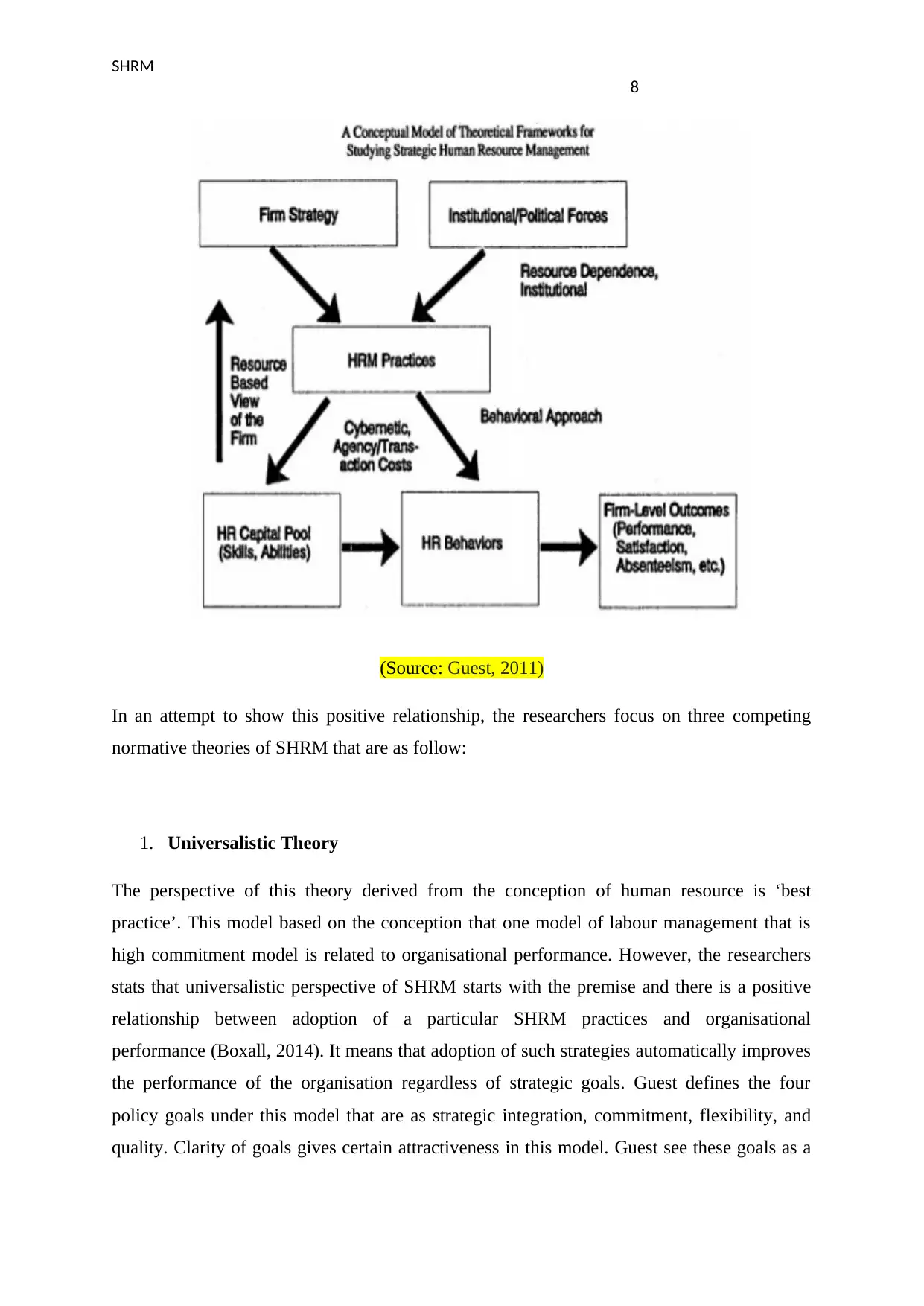
SHRM
8
(Source: Guest, 2011)
In an attempt to show this positive relationship, the researchers focus on three competing
normative theories of SHRM that are as follow:
1. Universalistic Theory
The perspective of this theory derived from the conception of human resource is ‘best
practice’. This model based on the conception that one model of labour management that is
high commitment model is related to organisational performance. However, the researchers
stats that universalistic perspective of SHRM starts with the premise and there is a positive
relationship between adoption of a particular SHRM practices and organisational
performance (Boxall, 2014). It means that adoption of such strategies automatically improves
the performance of the organisation regardless of strategic goals. Guest defines the four
policy goals under this model that are as strategic integration, commitment, flexibility, and
quality. Clarity of goals gives certain attractiveness in this model. Guest see these goals as a
8
(Source: Guest, 2011)
In an attempt to show this positive relationship, the researchers focus on three competing
normative theories of SHRM that are as follow:
1. Universalistic Theory
The perspective of this theory derived from the conception of human resource is ‘best
practice’. This model based on the conception that one model of labour management that is
high commitment model is related to organisational performance. However, the researchers
stats that universalistic perspective of SHRM starts with the premise and there is a positive
relationship between adoption of a particular SHRM practices and organisational
performance (Boxall, 2014). It means that adoption of such strategies automatically improves
the performance of the organisation regardless of strategic goals. Guest defines the four
policy goals under this model that are as strategic integration, commitment, flexibility, and
quality. Clarity of goals gives certain attractiveness in this model. Guest see these goals as a
⊘ This is a preview!⊘
Do you want full access?
Subscribe today to unlock all pages.

Trusted by 1+ million students worldwide
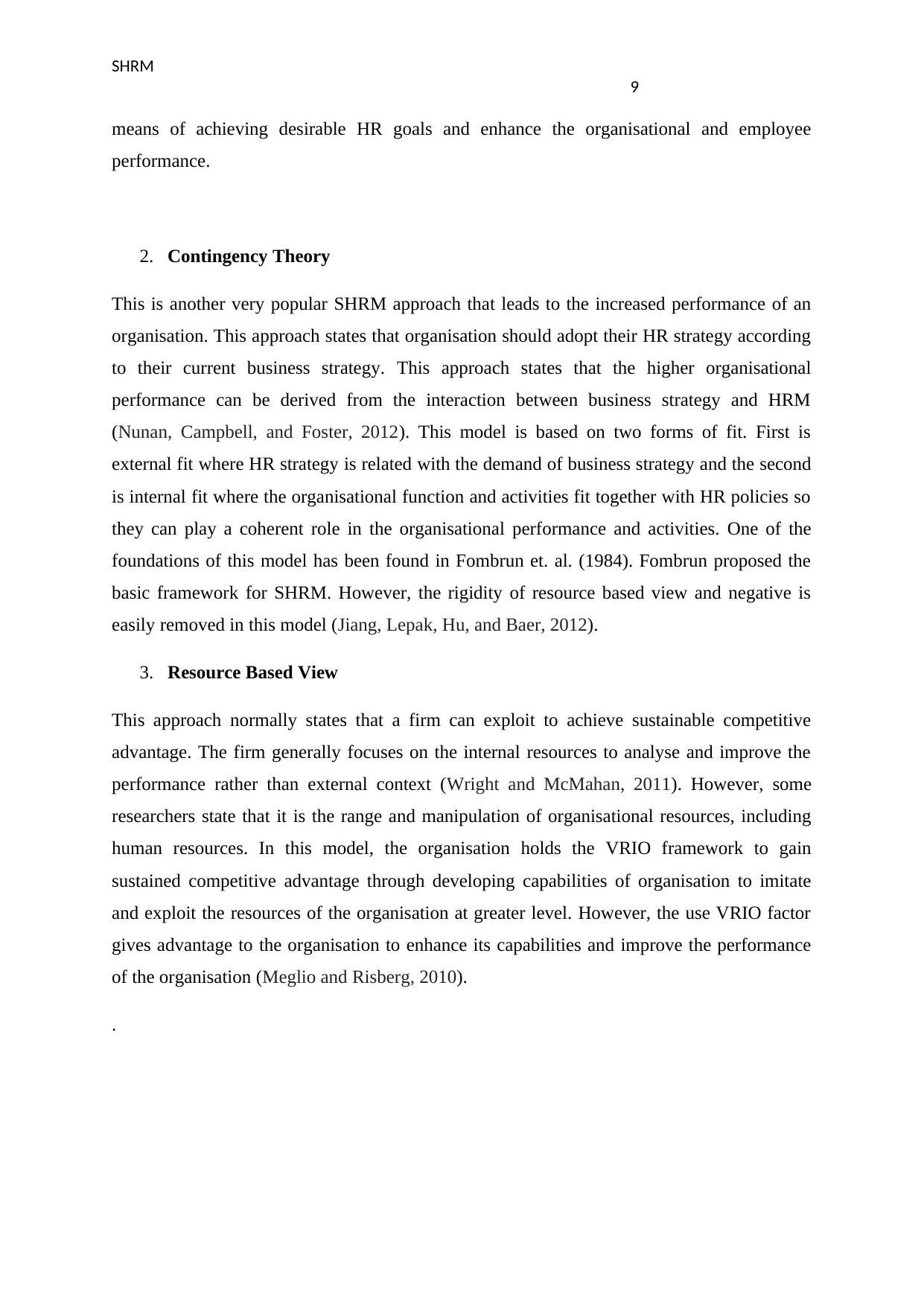
SHRM
9
means of achieving desirable HR goals and enhance the organisational and employee
performance.
2. Contingency Theory
This is another very popular SHRM approach that leads to the increased performance of an
organisation. This approach states that organisation should adopt their HR strategy according
to their current business strategy. This approach states that the higher organisational
performance can be derived from the interaction between business strategy and HRM
(Nunan, Campbell, and Foster, 2012). This model is based on two forms of fit. First is
external fit where HR strategy is related with the demand of business strategy and the second
is internal fit where the organisational function and activities fit together with HR policies so
they can play a coherent role in the organisational performance and activities. One of the
foundations of this model has been found in Fombrun et. al. (1984). Fombrun proposed the
basic framework for SHRM. However, the rigidity of resource based view and negative is
easily removed in this model (Jiang, Lepak, Hu, and Baer, 2012).
3. Resource Based View
This approach normally states that a firm can exploit to achieve sustainable competitive
advantage. The firm generally focuses on the internal resources to analyse and improve the
performance rather than external context (Wright and McMahan, 2011). However, some
researchers state that it is the range and manipulation of organisational resources, including
human resources. In this model, the organisation holds the VRIO framework to gain
sustained competitive advantage through developing capabilities of organisation to imitate
and exploit the resources of the organisation at greater level. However, the use VRIO factor
gives advantage to the organisation to enhance its capabilities and improve the performance
of the organisation (Meglio and Risberg, 2010).
.
9
means of achieving desirable HR goals and enhance the organisational and employee
performance.
2. Contingency Theory
This is another very popular SHRM approach that leads to the increased performance of an
organisation. This approach states that organisation should adopt their HR strategy according
to their current business strategy. This approach states that the higher organisational
performance can be derived from the interaction between business strategy and HRM
(Nunan, Campbell, and Foster, 2012). This model is based on two forms of fit. First is
external fit where HR strategy is related with the demand of business strategy and the second
is internal fit where the organisational function and activities fit together with HR policies so
they can play a coherent role in the organisational performance and activities. One of the
foundations of this model has been found in Fombrun et. al. (1984). Fombrun proposed the
basic framework for SHRM. However, the rigidity of resource based view and negative is
easily removed in this model (Jiang, Lepak, Hu, and Baer, 2012).
3. Resource Based View
This approach normally states that a firm can exploit to achieve sustainable competitive
advantage. The firm generally focuses on the internal resources to analyse and improve the
performance rather than external context (Wright and McMahan, 2011). However, some
researchers state that it is the range and manipulation of organisational resources, including
human resources. In this model, the organisation holds the VRIO framework to gain
sustained competitive advantage through developing capabilities of organisation to imitate
and exploit the resources of the organisation at greater level. However, the use VRIO factor
gives advantage to the organisation to enhance its capabilities and improve the performance
of the organisation (Meglio and Risberg, 2010).
.
Paraphrase This Document
Need a fresh take? Get an instant paraphrase of this document with our AI Paraphraser
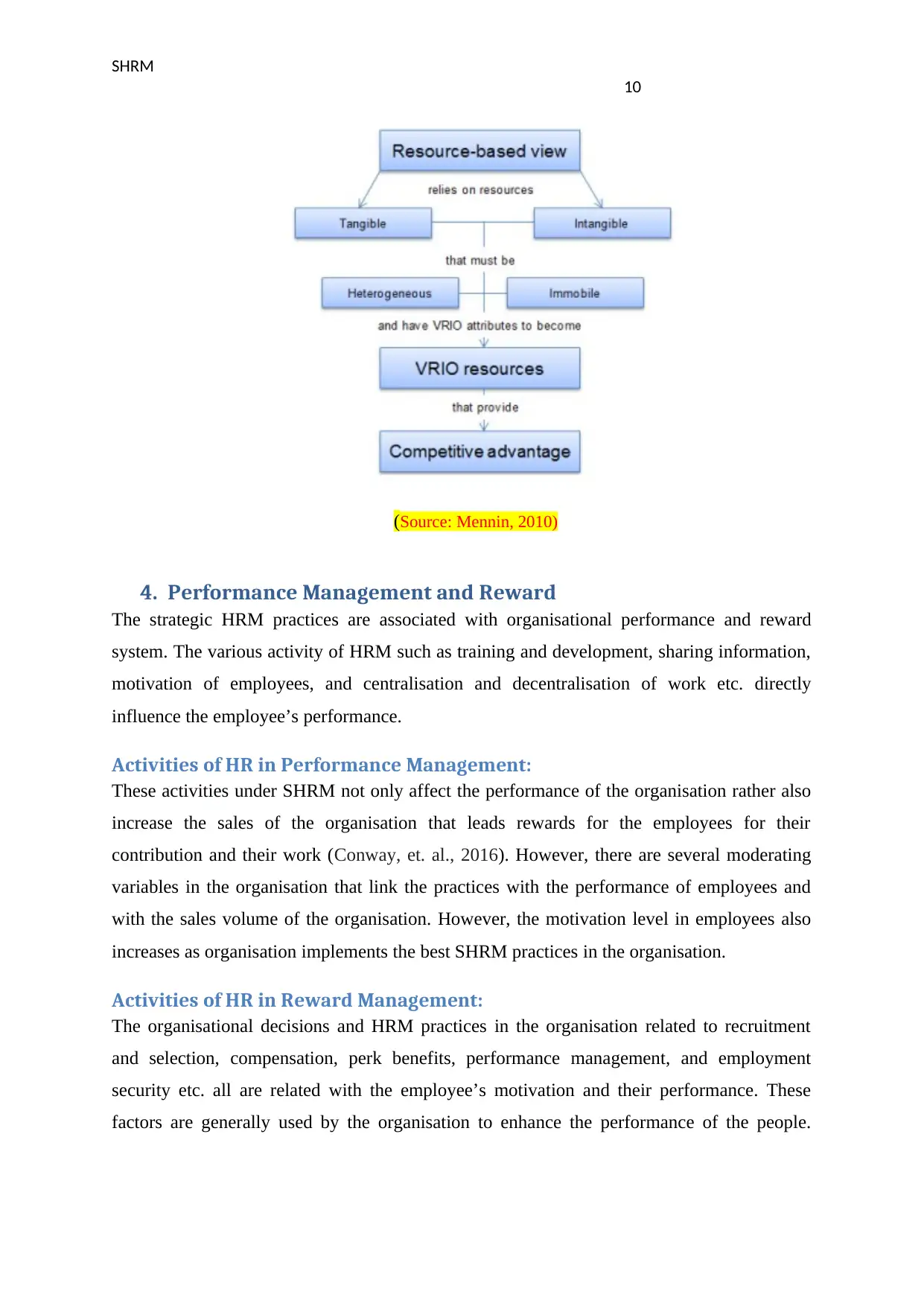
SHRM
10
(Source: Mennin, 2010)
4. Performance Management and Reward
The strategic HRM practices are associated with organisational performance and reward
system. The various activity of HRM such as training and development, sharing information,
motivation of employees, and centralisation and decentralisation of work etc. directly
influence the employee’s performance.
Activities of HR in Performance Management:
These activities under SHRM not only affect the performance of the organisation rather also
increase the sales of the organisation that leads rewards for the employees for their
contribution and their work (Conway, et. al., 2016). However, there are several moderating
variables in the organisation that link the practices with the performance of employees and
with the sales volume of the organisation. However, the motivation level in employees also
increases as organisation implements the best SHRM practices in the organisation.
Activities of HR in Reward Management:
The organisational decisions and HRM practices in the organisation related to recruitment
and selection, compensation, perk benefits, performance management, and employment
security etc. all are related with the employee’s motivation and their performance. These
factors are generally used by the organisation to enhance the performance of the people.
10
(Source: Mennin, 2010)
4. Performance Management and Reward
The strategic HRM practices are associated with organisational performance and reward
system. The various activity of HRM such as training and development, sharing information,
motivation of employees, and centralisation and decentralisation of work etc. directly
influence the employee’s performance.
Activities of HR in Performance Management:
These activities under SHRM not only affect the performance of the organisation rather also
increase the sales of the organisation that leads rewards for the employees for their
contribution and their work (Conway, et. al., 2016). However, there are several moderating
variables in the organisation that link the practices with the performance of employees and
with the sales volume of the organisation. However, the motivation level in employees also
increases as organisation implements the best SHRM practices in the organisation.
Activities of HR in Reward Management:
The organisational decisions and HRM practices in the organisation related to recruitment
and selection, compensation, perk benefits, performance management, and employment
security etc. all are related with the employee’s motivation and their performance. These
factors are generally used by the organisation to enhance the performance of the people.

SHRM
11
rewards management and HR An employee will always try to give their best if they
motivated by the organisation (Lengnick-Hall, Beck, and Lengnick-Hall, 2011).
(Source: Cartwright and Cooper, 2012)
5. Recommendations for Organisational Design Effective
Performance Management System
Employees are the important asset of any organisation, so managing their performance is
really crucial for the success of an organisation. To ensure effective performance
management system, client should care about the following recommendations:
11
rewards management and HR An employee will always try to give their best if they
motivated by the organisation (Lengnick-Hall, Beck, and Lengnick-Hall, 2011).
(Source: Cartwright and Cooper, 2012)
5. Recommendations for Organisational Design Effective
Performance Management System
Employees are the important asset of any organisation, so managing their performance is
really crucial for the success of an organisation. To ensure effective performance
management system, client should care about the following recommendations:
⊘ This is a preview!⊘
Do you want full access?
Subscribe today to unlock all pages.

Trusted by 1+ million students worldwide
1 out of 21
Related Documents
Your All-in-One AI-Powered Toolkit for Academic Success.
+13062052269
info@desklib.com
Available 24*7 on WhatsApp / Email
![[object Object]](/_next/static/media/star-bottom.7253800d.svg)
Unlock your academic potential
Copyright © 2020–2025 A2Z Services. All Rights Reserved. Developed and managed by ZUCOL.




